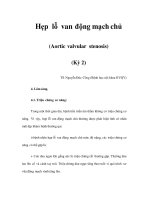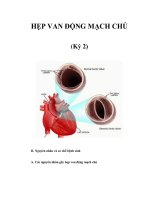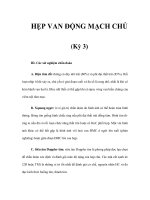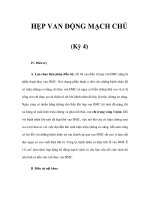Bệnh van động mạch chủ không có triệu chứng nên làm gì
Bạn đang xem bản rút gọn của tài liệu. Xem và tải ngay bản đầy đủ của tài liệu tại đây (544.08 KB, 21 trang )
Asymptomatic Aortic Valve Disease
What Should We Do?
Michael Rinaldi, MD
The Sanger Heart and Vascular Institute
Carolinas HealthCare System
Charlotte NC USA
Disclosures
Nothing relevant to the presentation
2014 AHA/ACC Guideline for the
Management of Patients With
Valvular Heart Disease
2014 AHA/ACC Guideline for the Management of Patients With
Valvular Heart Disease (Journal of the American College of
Cardiology). Published on March 3, 2014, available at:
and
/>000029.citation
The full-text guidelines are also available on the following Web sites:
ACC (www.cardiosource.org) and AHA (my.americanheart.org)
Aortic Stenosis
Severity Assessment
Indicator
Mild
Moderate
Severe
CW Jet Velocity (m/sec)
< 3.0
3.0-4.0
> 4.0
Mean Gradient (mm Hg)
< 25
25 - 40
> 40
< 1.0
Valve Area (cm2)
Echo f/u
> 1.5
3-5 yrs
*(or Δ in sx’s)
1.0 – 1.5
(Index <0.6
cm2/m2)
1-2 yrs*
Yearly
.
Circulation. October 2008;118:e523-e661
Case Example
• 75 year old man with systolic murmur
• Asymptomatic but inactive
• Echocardiography shows a thickened poorly
mobile valve with an AV velocity of 4.0 m/s
and mean gradient of 42 mmHg
• Should this patient have AVR?
Diagnostic Testing – Diagnosis and Follow-Up
Recommendations
Cardiac catheterization for hemodynamic
assessment is recommended in symptomatic
patients when noninvasive tests are inconclusive
or when there is a discrepancy between the
findings on noninvasive testing and physical
examination regarding severity of the valve lesion
Exercise testing is reasonable in selected
patients with asymptomatic severe VHD to 1)
confirm the absence of symptoms, or 2)
assess the hemodynamic response to
exercise, or 3) determine prognosis
COR
LOE
I
C
IIa
B
Case Example
• ETT is performed
– Poor exercise tolerance
– Hypotensive response exercise
– Ventricular ectopy
• This patient is a high risk for mortality and is
functionally symptomatic and therefore
should have AVR
Another Method of Assessment
Emerging Roll of CT Derived AV
Calcium Score in AS Assessment
• AV calcium score >1274 in Women and >2065 in Men
associated with far worse prognosis
• AVR indicated
Clavel, M. JACC 2014;64.1202-13.
Example of CTA of AV with High
Calcium Score
A Twist on our Case Example
• 75 year old man with systolic murmur
• Asymptomatic but inactive
• Severe class 4 kidney disease, DM, moderate
COPD, appears frail
• Echocardiography shows a thickened poorly
mobile valve with an AV velocity of 4.0 m/s and
mean gradient of 42 mmHg
• Should this patient have AVR?
Risk Assessment for Surgical AVR
Combining STS Risk Estimate, Frailty, Major Organ System
Dysfunction, and Procedure-Specific Impediments
STS PROM
Frailty
Major organ
system
compromise not
to be improved
postoperatively
Procedurespecific
impediment
Low Risk (must
meet ALL criteria
in this column )
<4%
AND
None
AND
Intermediate Risk
(any 1 criteria in
this column)
4% to 8%
OR
1 index (mild)
OR
High Risk
(any 1 criteria in
this column)
>8%
OR
2 or more indices
(moderate-tosevere)
OR
No more than 2
organ systems
OR
Prohibitive Risk
(any 1 criteria in this
column)
Predicted risk with surgery
of death or major morbidity
(all-cause) >50% at 1 y
OR
None
AND
1 organ system
OR
None
Possible procedure- Possible procedure- Severe procedure-specific
specific impediment specific impediment impediment
3 or more organ systems
OR
A Variation on our Case Example
• STS predicted mortality risk 8%
• Goal here is quality of life and symptoms relief
• We should not operate
• Consider TAVR when patient becomes
significantly symptomatic (> Class 2)
Case Example
• 65 year old man
• Asymptomatic and active
• Echocardiography shows a thickened poorly
mobile valve with an AV velocity of 5.0 m/s and
mean gradient of 55 mmHg
• Normal LVEF
• No high risk markers on ETT
• Low risk for AVR
• Should this patient have AVR?
Aortic Stenosis: Timing of Intervention (cont.)
Recommendations
COR LOE
AVR is reasonable for asymptomatic patients
with very severe AS (stage C1, aortic velocity
IIa
B
≥5 m/s) and low surgical risk
AVR is reasonable in asymptomatic patients (stage
C1) with severe AS and decreased exercise
IIa
B
tolerance or an exercise fall in BP
AVR is reasonable in symptomatic patients with
low-flow/low-gradient severe AS with reduced
LVEF (stage D2) with a low-dose dobutamine
IIa
B
stress study that shows an aortic velocity 4 m/s
(or mean pressure gradient 40 mm Hg) with a
valve area 1.0 cm2 at any dobutamine dose
Case Example
• 75 year old man with systolic murmur
• Dyspnea on exertion
• Echocardiography shows a thickened poorly
mobile valve with an AV velocity of 3.0 m/s and
mean gradient of 30 mmHg
• LVEF 30%
• Does this patient have symptomatic AS or just
systolic CHF?
• Should this patient have AVR?
Aortic Stenosis: Timing of Intervention (cont.)
Recommendations
COR LOE
AVR is reasonable for asymptomatic patients with
very severe AS (stage C1, aortic velocity ≥5 m/s)
IIa
B
and low surgical risk
AVR is reasonable in asymptomatic patients (stage
C1) with severe AS and decreased exercise
IIa
B
tolerance or an exercise fall in BP
AVR is reasonable in symptomatic patients with
low-flow/low-gradient severe AS with reduced
LVEF (stage D2) with a low-dose dobutamine
stress study that shows an aortic velocity 4
IIa
B
m/s (or mean pressure gradient 40 mm Hg)
with a valve area 1.0 cm2 at any dobutamine
dose
Case Example
• DSE at 5, 10, and 20 mcg/kg/min shows LVEF
increases and AV velocity of 4.0 m/s and mean
gradient of 42 mmHg
• Consistent with “low flow low gradient”
severe AS
• This patient should have AVR (consider TAVR)
Case Example
•
•
•
•
75 year old man with systolic murmur
Unstable angina with LM and 3 vessel CAD
Scheduled to undergo CABG
Echocardiography shows a thickened poorly
mobile valve with an AV velocity of 3.0 m/s
and mean gradient of 32 mmHg
• Should this patient have AVR?
Aortic Stenosis: Timing of Intervention (cont.)
Recommendations
COR LOE
AVR is reasonable in symptomatic patients who
have low-flow/low-gradient severe AS (stage D3)
who are normotensive and have an LVEF ≥50% if
IIa
C
clinical, hemodynamic, and anatomic data support
valve obstruction as the most likely cause of
symptoms
AVR is reasonable for patients with moderate AS
(stage B) (aortic velocity 3.0–3.9 m/s) who are
IIa
C
undergoing other cardiac surgery
AVR may be considered for asymptomatic patients
with severe AS (stage C1) and rapid disease
IIb
C
progression and low surgical risk
Indications for Aortic Valve Replacement in Patients With Aortic Stenosis
Thank you









